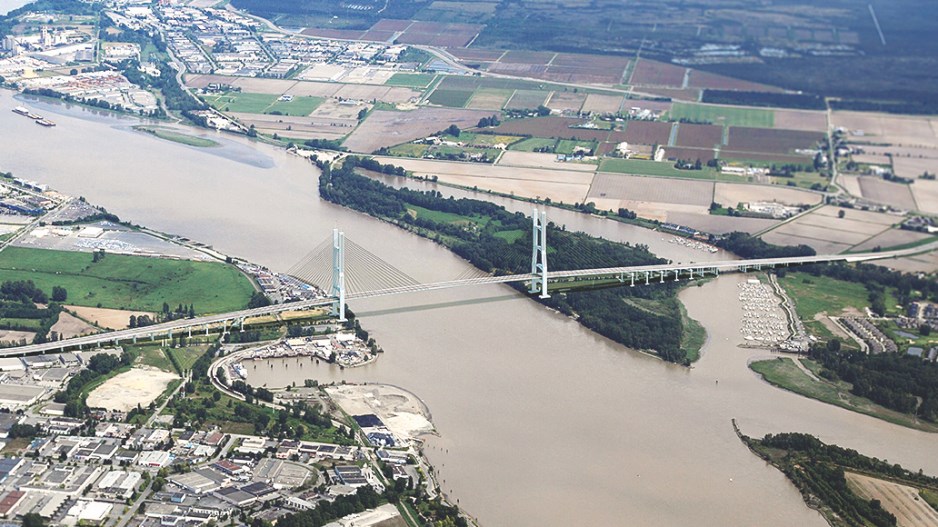Replacing the George Massey Tunnel with a new multi-lane bridge is about more than easing the pain of commuters, say both proponents and opponents of the plan announced by Premier Christy Clark on September 20.
At stake is a vital marine shipping route up the Fraser River, development pressures on the agricultural land reserve (ALR) and the future of public transit for the region.
"The Fraser River has a bigger impact to the country than the St. Lawrence Seaway," Iain Black, president and CEO of the Vancouver Board of Trade, told Business in Vancouver.
"The magnitude of this economically should not be discounted. This is much more than just a transit conversation or a transportation conversation."
Clark's announcement that construction on the new bridge would begin in 2017 surprised many. The province had wrapped up consultation sessions on the future of the tunnel in March. Several possibilities were on the table at that time, including twinning the tunnel.
That's the option favoured by Richmond city councillor Harold Steves, because he said it would have provided space for a light rail transit (LRT) line as well as more lanes for vehicles at a much lower cost than building a bridge and removing the existing tunnel.
"Really all we need is the LRT because we have no transit in Delta, White Rock and South Surrey; they all have to go by car. If we had an LRT line running down there I think that would probably solve the whole problem."
Steves added that the real motivation behind the bridge is opening up the Fraser River to large ocean-going vessels, something the tunnel restricts.
"They want to develop the Fraser River as a highly industrialized river, which it was never intended to be," he said.
But to keep up with modern shipping standards, more depth in the Fraser will inevitably be needed, said Tom Corsie, vice-president of real estate for Port Metro Vancouver.
That's because as the cost of fuel has risen, ships have been getting bigger to maximize fuel efficiency. A planned Panama Canal expansion in 2014 is also part of the trend toward super-sized tankers and container ships.
Corsie said there are already several important shipping terminals on the Fraser River. Every car coming to Canada from Asia goes through a terminal on Annacis Island. Fraser Surrey Docks (FSD) handles lumber, agricultural products and steel; if the port approves a proposed expansion, FSD will handle up to four million metric tonnes of coal.
The Vancouver Airport Fuel Facilities Corp. has also proposed shipping jet fuel up the Fraser to meet up with a planned new pipeline.
"It's true that if the tunnel is left in place, there will be no chance to deepen the channel," said Corsie.
For transit advocate Gordon Price, new roads and bridges lead back to one place: the roadblock over transit funding for Metro Vancouver.
"What's the vision, the strategy?" asked Price, a former Vancouver city councillor and now director of Simon Fraser University's city program.
Price said he connects the Massey bridge announcement with the upcoming transit referendum, which has yet to find a question or a clear political leader. If the region remains deadlocked on how to fund transit, said Price, that leaves a future where suburban sprawl continues to grow and everyone drives to the mall. In an email sent to BIV, the Ministry of Transportation said the new bridge would "open the corridor up to future rapid transit options," but did not outline what those options would be or how they would be funded.
The ministry also said the bridge had been chosen over the tunnel twinning option because the existing tunnel is not seismically safe and there would be no room for pedestrians and cyclists. •
Removing the George Massey Tunnel would be only the first part of a process to make the Fraser River navigable for the enormous cargo ships that are becoming more common.
The river would also need to be dredged deeper, an option Jeff Scott, CEO of Fraser Surrey Docks, advocates as a project that would benefit B.C.'s economy.
But dredging deeper would be a major costly engineering project, said Tom Corsie, vice-president of real estate for Port Metro Vancouver.
Currently, Port Metro Vancouver contracts local dredging company Fraser River Pile and Dredge to regularly clear out the river as the Fraser is hit with an infusion of silt every year during the spring runoff season.
"If we look at the business case to make it deeper, it's really difficult," said Corsie. It's really up to [Fraser Surrey Docks] to give us a business case to convince us to make that investment."
That investment would include both capital and ongoing maintenance costs.
Port Metro Vancouver currently spends roughly $15 million to dredge the Fraser per year, but recovers around $10 million in sand sales to cement manufacturers.




